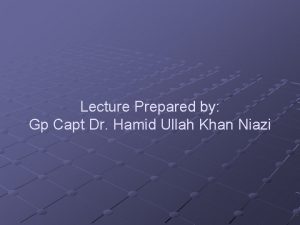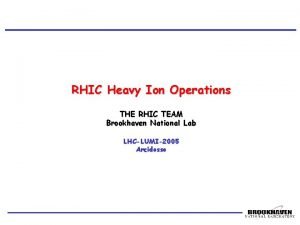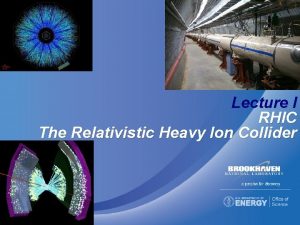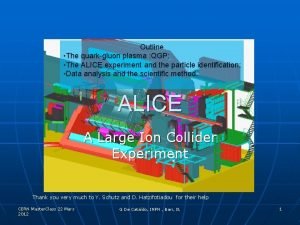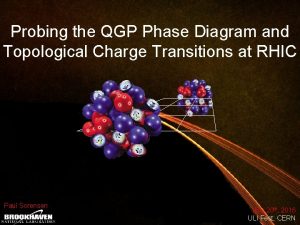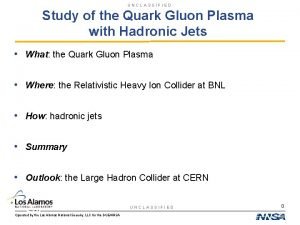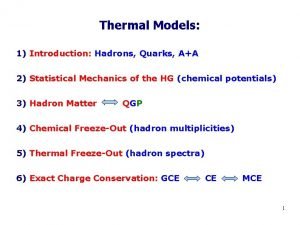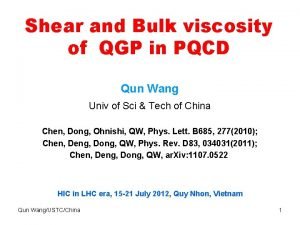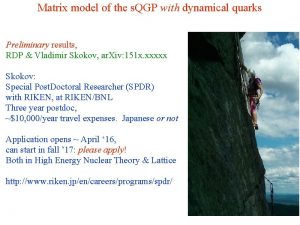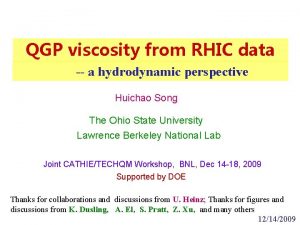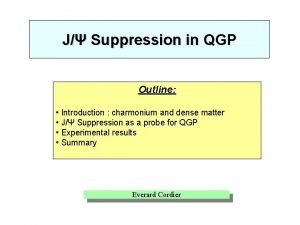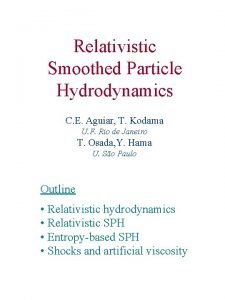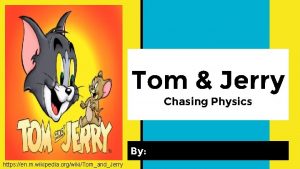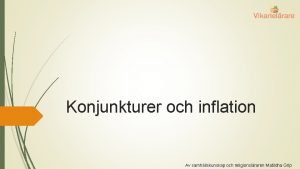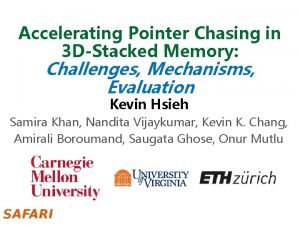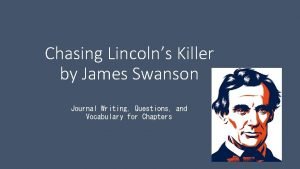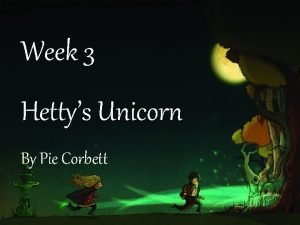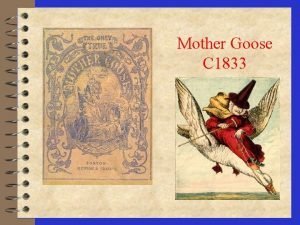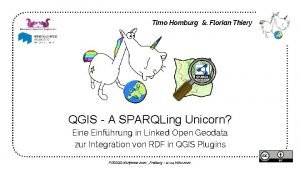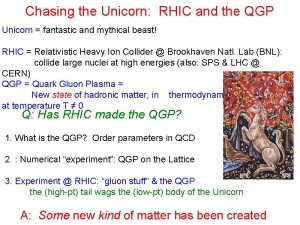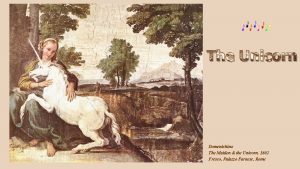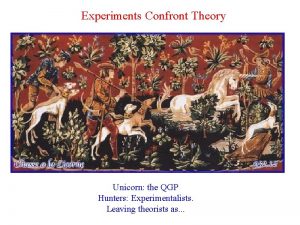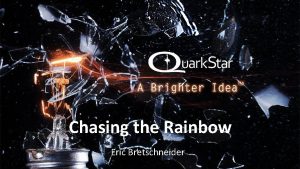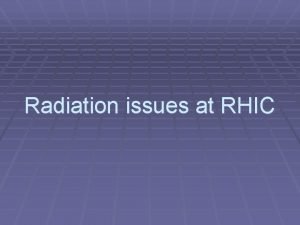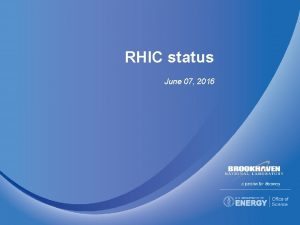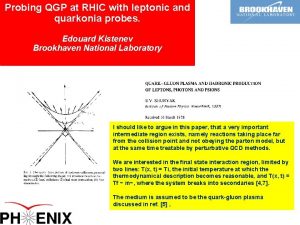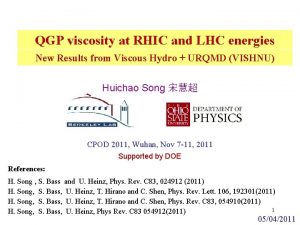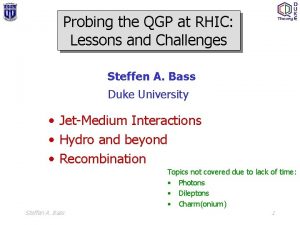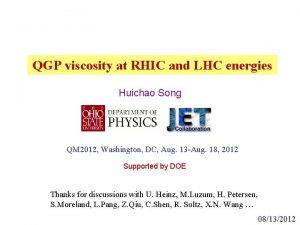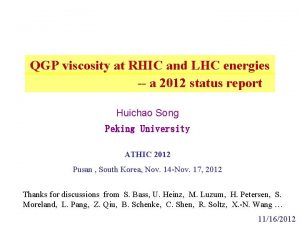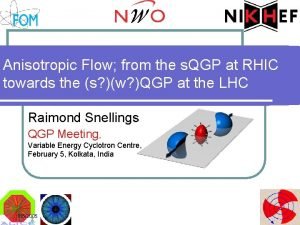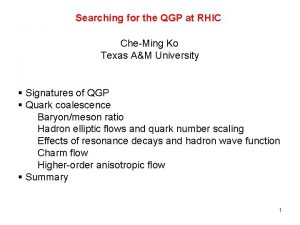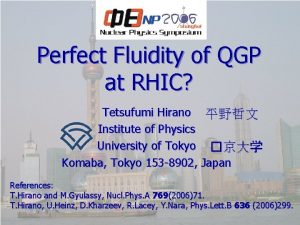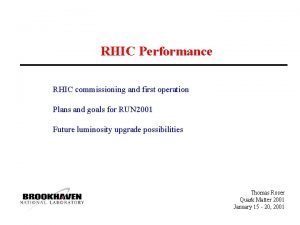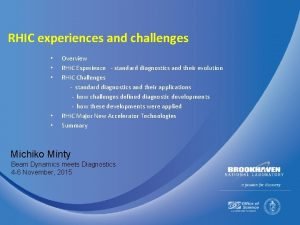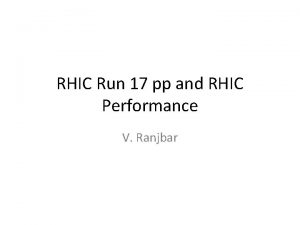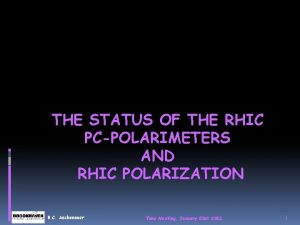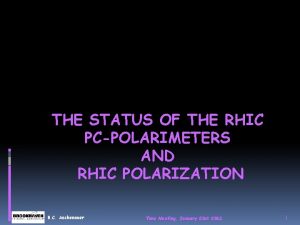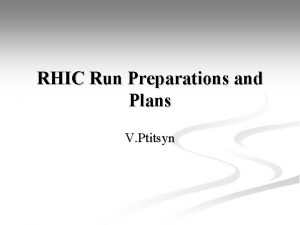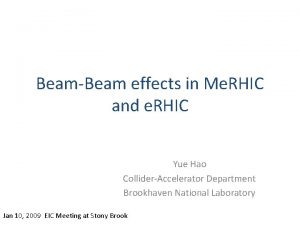Chasing the Unicorn RHIC and the QGP Unicorn













































- Slides: 45

Chasing the Unicorn: RHIC and the QGP Unicorn = fantastic and mythical beast! RHIC = Relativistic Heavy Ion Collider @ Brookhaven Natl. Lab (BNL): collide large nuclei at high energies (also: SPS & LHC @ CERN) QGP = Quark Gluon Plasma = New state of hadronic matter, in thermodynamic equilibrium at temperature T ≠ 0 Q: Has RHIC made the QGP? 1. QCD @ nonzero temperature: what is the QGP? 2. The QGP on the Lattice: numerical “experiment” 3. “Gluon Stuff” @ RHIC: the (high-pt) tail wags the (low-pt) body of the Unicorn A: Some new kind of matter has been

QCD at nonzero temperature: restoration of chiral symmetry Like a magnet: broken at low temperature, restored at some finite temperature. up & down quarks: “flavor” symmetry = with strange: In broken phase, (approx. ) “spin waves” = (almost massless) pions, K’s, η (What about η’ from extra axial U(1)? Instantons. . Could dramatically affect transition properties with light quarks. )

Deconfinement as a Global Z(3) Symmetry Multiply each quark by a constant phase: Mesons and baryons don’t change: but q, qq, etc, do not. Could use exp(- 2 π i/3), too = Z(3) symmetry. Z(3) spin = Polyakov loop = propagator “test” quark => = (trace) color Aharonov-Bohm phase. g = QCD coupling constant. For small g, loop ~ 1. Only valid in a pure gauge theory, without dynamical quarks. In QCD, is the Z(3) symmetry approximate?

Deconfinement & Polyakov Loops ‘t Hooft: part of local SU(3) is global Z(3) At T=0, confinement => quarks don’t propagate => UNbroken Z(3) symmetry As T→∞, by asymptotic freedom, g^2 small, pert. thy. ok, => loop is near one (times Z(3) phase). => deconfined phase in which quarks propagate: Deconfinment opposite to spins: Z(3) broken at high, and not low, temp.

Order of Phase Transitions Relation between deconfining and chiral transitions? 1 or 2 trans. ’s? For QCD, both Z(3) and chiral symmetries are approximate. Strongly First Order Transition(s)? “Of course”! Hadrons ≠ Quarks & Gluons. Limits: Deconfining transition (NO quarks): cubic invariant is Z(3) symmetric: first order deconfining trans. (Svetitsky & Yaffe). # colors => ∞: first order deconf. ’g trans. Chiral transition: two massless flavors: O(4) sym. => second order chiral trans. three massless flavors: cubic invariant => first order chiral trans.

The “Unicorn”: Quark-Gluon Plasma = Deconfined, Chirally Symmetric “Phase” at nonzero temperature But how to compute properties of the QGP?

QGP on the Lattice: compute from first principles as lattice spacing a=>0. 2004: Only gluons (no qks, pure gauge): present methods close to a=0! T_d ~ 270 ± 10 Me. V Weakly first order deconfining trans. (Some masses ↓ by ~10). Non-perturbative QGP from T_d => 3 T_d. No “of course” QCD: present methods not close to a=0. All results tentative. T_c ~ 175 ± ? Me. V Only one transition (chiral = deconfining)

Lattice: pressure vs temp. , pure glue to QCD p(T)=pressure. Asymptotic freedom => p/T^4 = const. as T →∞ <=ideal gas: 2+1 flavors = QCD p/T^4↑ <=ideal gas: pure glue T=> Pure glue: ↑Tc ~ 270. 1 st order phase transition 2+1 fl’s = QCD: ↑Tc ~ 175. No phase transition:

Lattice: “Flavor Independence” Lattice finds amazing property: properly scaled, pressure with quarks like that without: Bielefeld. 1. 0=> => pressure dominated by gluons? pressure/ ideal gas↑ T/Tc=>

Non-pert. QGP for Tc => ~ 3 Tc Ren. ’d Polyakov loop with qks ~ as pure gauge => dominated by gluons? Pert. thy: loop near one. Loop far from one: non-pert. regime. <= => Non-pert. QGP => “Pert. ” QGP Bielefeld: lat/0312015 c/o quarks Ren’d Polyakov loop ↑ with quarks Tc Two flavors, kaon masses T/Tc=>

Early universe @ ~μsec: QCD phase transition In AA collisions, rapid expansion. Not sensitive to (weakly) 1 st order transition, indicated by lattice. In early universe, slow expansion. Sensitivity of nucleosynthesis to 1 st order trans? Goal for lattice: order of the QCD phase trans. ‘ 04: crossover. ‘ 08?

The QGP Exists! Hunting for the “Unicorn” in Heavy Ion Collisions “Unicorn” & the QGP: Scott, Stock, Gyulassy. . . Hunters = experimentalists, “all theorists are dogs. . . ”

Why do AA? Big transverse size. One can collide: pp: protons on protons. Benchmark for “ordinary” strong int. ’s AA: nucleus with atomic number A on same. d. A: deuteron (N+P) on nucleus. Serves as another check. Why AA? Baryons are like hard spheres, so nuclear size Biggest: Pb (lead) or Au (gold), A ~ 200 => r_A ~ 7. Transverse radius of nucleus proton. => trans. size ~ 50 x A ~ 200 close to A →∞ = infinite nuclear matter?

AA collisions at high energy: where? Basic invariant: total energy in the center of mass, For AA collisions, energy per nucleon is Machines SPS @ CERN **** RHIC @ BNL 5 => 17 Ge. V fixed target 20, 130, 200 Ge. V collider, > 2000 5500 Ge. V = 5. 5 Te. V collider, > 2007 LHC @ CERN SIS 200 @ GSI 2 => 6 Ge. V fixed target, > 2010 SPS = Super Proton Synchotron: CERN @ Geneva, Switzerland. RHIC = Relativistic Heavy Ion Collider: BNL @ Long Island, NY. LHC = Large Hadron Collider.

Essentials of AA collisions At energies >> mass, nuclei slam through each other. Particles very different along beam direction, vs. transverse to beam. In collider: ignore along beam; look just perpendicular to beam ”central” or zero rapidity (rapidity ~ velocity along beam. ) 90° to beam => few baryons => most likely to see nonzero temp. Consider distribution of particles only in transverse momentum, p_t Peripheral=> Central: Most particles at p_t = 0, fall off with increasing p_t. Thermal? Maximum Overlap “Almond” of overlap region

Typical Heavy Ion Event @ RHIC Experiments @ RHIC: “Big” expts: ~ 400 people STAR & PHENIX “Small” expts. : ~ 50 people PHOBOS & BRAHMS Note: total # particles ~ total # experimentalists ~ log(total energy) # theorists ~ log(total energy)). Total # particles(/unit rapidity) ~ 900↓

Particle Distributions vs η, Energy: “Central Plateau” @ RHIC 200 Ge. V: Central 200 Ge. V = Highest energy @ RHIC 900 particles/unit η 200 Ge. V: d. N/dη/ ↑ # participants Peripheral N = # particles Particle dist. ’s qualitatively same between central & peripheral. 19 Ge. V = 19 Ge. V: Central Highest energy @ SPS 19 Ge. V: 600 particles/unit η Peripheral η = pseudo-rapidity No big changes in overall multiplicity

Why do AA? “Saturation” as a Lorentz Boost At high energies, incident nucleus is Lorentz contracted. => color charge of incident nucleus gets “squashed”. Mc. Lerran & Venugopalan: color charge bigger by : can use semi-classical methods. @ central rapidity, gluon saturation = Color Glass. As semi-classical, predicts logarithmic growth in multiplicity: First surprise from Day 1: NO big increase in multiplicity. Approx. log growth.

Slow Growth in Multiplicity with Energy Models prior to RHIC SPS <=Color Glass Condensate RHIC Good fits to overall multiplicity, centrality dependence (Kharzeev, Levin, Nardi) STAR: from 130 => 200 Ge. V, multiplicity increases by 14%,

Body of the “Unicorn”: Majority of particles, at small momenta < 2 Ge. V. Tail of the “Unicorn”: Look at particles at HIGH momentum, p_t > 2 Ge. V, to probe the body. The Tail wags the (Dog) Unicorn

Jets: “seeing” quarks and gluons in QCD 2 jets from pp collision: Quarks & gluons => jets. STAR @ RHIC <= jets in pp @ RHIC. For each jet, there is a backward je Jets can be computed at high energy in pert. thy. , down to --50 Ge. V? 5 Ge. V? Vogelsang et al =>

“Jets” in central AA collisions pp collisions: ~ 4 particles/unit rapidity, vs 900 in central AA. Hence hard to see individual jets in AA. Can construct statistical measures. p_t = momentum transverse to beam Trigger on “hard” particle, p_t: 4 => 6 Ge. V Given a jet in one direction, there must be something in the opposite direction. Look for the “away” side jet, p_t > 2 Ge. V. (mass proton ~ 1 Ge. V)

Central AA collisions “eat” jets! In pp or d. Au collisions, clearly see away side jet. In central Au-Au, away side jet gone: “stuff” in central AA “eats” jets! Fast jet tends to lose energy by many soft scatterings off “stuff”. forward jet=> <= backward jet, pp <= NO backward jet in central AA

eripherhal Coll. ’s: Geometrical Test that AA Eats Je Peripheral collisions, “stuff” forms “almond”: a jet travels farther through the almond, out of the reaction plane, than in the plane. Exp. ’y: backward jet more strongly suppressed out of plane than in plane => geometrical test that central AA “eats” jets out of plane jet in plane jet STAR preliminary peripheral collision ↑ almond = “stuff”

Central AA: high p_t jets give low p_t remains! Trigger on all particles, p_t >. 15 Ge. V. Backward jet: high p_t suppressed, low p_t enhanced. “Stuff” in central AA slows fast particle down. Forward jet: enhanced at low momentum: “stuff” dragged along! STAR prelim. raw => spectra enhancement at low p_t along jet => <= enchancement at low p_t backward to trigger jet 1> ratio, AA/pp => forward part. ’s ↑ AA=pp <=suppressio n backward part. ’s ↑ at high p_t

Clear Experimental Signal of “Stuff”: R_AA Compare central AA spectra to pp spectra, esp. “hard” pt > 2 Ge. V: R_AA = # particles at a given p_t, in central AA collision/ (# part’s at the same p_t in pp, central rapidity x A^{4/3}) R_AA => R_AA suppression of hard particles in AA, vs pp. p_t > 6 Ge. V, ~ constant suppression.

R_AA: Enchancement @ SPS, Suppression @ Effect most dramatic for π^0’s. RHIC SPS: R_AA ~ 2. 5 @ 3 Ge. V. “Cronin” RHIC: R_AA ~ 0. 2 @ 3 Ge. V. RHIC: Supp. from energy loss - “stuff” slows fast particles down. SPS=> RHIC↓ PHENIX

R_AA final state effect: not seen in R_d. A: like R_AA, but for d. A/pp. Central rapidity (y=0): “Cronin” enhancement in d. A, vs suppression in AA. NO “color glass” suppression. Mc. Lerran, Venugopalan, Kharzeev, Iancu. . . AA=> <=d. A Suppression in AA ↑ R_AA ~ 0. 4 @ 3 Ge. V Enhancement in d. A ↑ R_d. A ~ 1. 4 @ 3 Ge. V

R_AA: Qualitative Agreement with “Energy Loss” Energy Loss: A fast particle going through a thermal bath loses energy: Landau, Pomeranchuk, Migdal ‘ 50’s Gyulassy, X. N. Wang, Vitev. . . Baier, Dokshitzer, Mueller, Schiff, Zakharov <= Gyulassy & Vitev: conspiracy to give flat R_AA @ RHIC. Need to add “Cronin”, shadowing. . . Is “flat” R_AA for π^0’s special

Where to find the Color Glass: d. A, by the proton Fragmentation region: like looking in the rest frame. Incident projectile gets Lorentz contracted: proton fragmentation region nuclear fragmentation region Nuclear frag. region: proton contracted. Study final state effects Proton frag. region: study initial state effects (Dumitru & Jalilian-Marian, Gelis. . . )

d. A, by the proton: suppresion! BRAHMS in d. A, enhancement @ central rapidity (per. to beam) suppression @ proton frag. region. (along beam) Supports color glass initial state. <= central rapidity: enhancement R_d. A↑ <= proton fragmentation region: suppression

Central AA: at p_t 2=>6 Ge. V , no baryon supp. R_CP: ratio for # particles at given p_t, for central to peripheral collisions Behaves like R_AA, easier to get data. Find: baryons not suppressed for pt: 2=> 6 Ge. V, mesons are. Mesons suppressed => “stuff” is gluonic. PHENIX R_CP↑ p_t (Ge. V)=>

Baryon “Bump” at p_t: 2 => 6 Ge. V Central AA: baryon “bump” at p_t: 2 => 6 Ge. V Baryon/meson ratio enhanced by ~3 in central AA vs pp. First seen in p/π. <= Λ/K ratio: bump peaks at ~ 3 Ge. V. Above p_t = 6 Ge. V, ratios like pp. R_CP vs particle species => All particles suppressed > 6 Ge. V, R_CP ~ 0. 2. => Gluon “stuff” supp. ’s mesons, generates baryon “bump”

d. A: No “Cronin” Enhancement at High p_t At high p_t, all R’s (R_AA & R_CP) should go to one. In d. A, seen in R_CP for p_t ~ 8 Ge. V. R_CP ↑ p_t=> At what p_t does R_AA => 1? > 10 Ge. V!

Direct Photons Measured Direct photons: easily escape, so probe initial state. Without pion suppression, very hard to measure (true at SPS). With observed suppression of π^0’s, measurable. Reasonable agreement at p_t ~ 10 Ge. V with Next to Leading Order QCD calculation, = pp times # binary collisions. <=== NLO QCD, Vogelsang. . . PHENIX, prelim. => <= signal c/o π suppression p_t (Ge. V)=> 10

The “body” of the unicorn: soft p_t < 2 Ge. V Particles peaked about zero (transverse) momentum Tc ~ 200 Me. V: expect thermal to p_t ~ 2 Ge. V. Thousands of particles, hydrodynamics should be ok. . . “dog”=> <=unicorn

Total Chemical Ratios Appear in Thermal Equilibrium OVERALL chemical abundances well fit with T_ch = 175 Me. V, μ_baryon ~0 (Becattini, Braun-Munziger, Letessier, Rafelski, Redlich, Stachel, Tounsi. . . )

Exact critical point in plane of T & μ Similar fits also work at lower energies. Need baryon chemical potential, μ. (Apparent) T_ch in p. A, pp - everywhere! => NOT conclusive. N. B. : in T-μ plane, expect exact critical point GSI ! <= critical point GSI? X Temperature↑ μ= baryon chem. pot. => ↑nuclear matter

p_t Spectra Appear In Thermal Equi. ~ Hydrodyamics Local Boost Velocity Hydro. gives good description for most particles, at low p_t< 1 Ge. V. Assumes initial conditions: starts above Tc in thermal equilibrium, simple Equation of State (1 st order!) Ideal hydro. : NO viscosity. . . <=soft hard=> Large local boost velocity β~. 7 c. Spectra of heavy particles “turn over” at low p_t. β=β(radius). RHIC: first clear evidence for boost velocity: big! p_t => Direct fits similar: “Blast-wave” Hydro needs to assume applicable from very early times, . 6 fm/c!

Success of Hydro. : v 2 = Elliptical Flow Peripheral Coll. ’s: Start with system which is anisotropic in momentum space. Exp. ’y, compute how spatial anistropy => momentum anistropy. (Ollitrault, Borghini) v 2 => collective behavior: there is “stuff”, and it sticks. Hydro works for v 2 @ RHIC, not SPS. v_2 ↑

At Low p_t < 1 Ge. V, Hydro. works for All Particles <= Hydro works for v_2 to p_t ~ 1 Ge. V for π’s, K’s, p’s, Λ’s. . everything. For all particles, v_2 flat for p_t > 1 Ge. V => 10 Ge. V - ? ! Is v_2 at p_t>1 Ge. V measuring collective flow, or jet-jet correlations? Apparently: true collective flow. So why flat? PHENIX Vertical bar : stat. error curves, Gray Box : sys. error The data point : at <p. T> in the bin

HBT Radii: Hydro Fails. “Blast Wave” Works Hanbury-Brown-Twiss: two-particle correlations for identical particles Sizes at freezeout. Three directions, Bertsch & Pratt: along beam R_long. , along line of sight R_out, perpendicular R_side. Hydro: R_out/R_side > 1, increases with p_t. Exp. : R_out/R_side ~ 1, decreases with p_t! Hydro: R_long, R_out too big. Peripheral coll. ’s: azimuthally Asym. HBT

HBT radii ~ same in pp, d. A, and AA! Can also measure HBT in pp, d. A. . . Ratios behave ~ same with p_t! Can fit HBT radii to “blast wave” = fit not fundamental model. Blast wave suggests: lifetime ~ 8 -9 fm/c, emission ~ 2 fm/c (No big times from strong 1 st order!) Space-time history “exploding shell” HBT => universal hadronization? Fluctuations (p_t. . . ) NOT same in pp, d. A, AA. . m_t ~ p_t=> STAR prelim.

Has RHIC found (tamed) the “Unicorn” = QGP? New final state effects: R_AA Suppression of backward jets Also: new initial state effects, BRAHMS: Color Glass in forward d. A Exp. ’y: for the unicorn of central AA, the high p_t “tail” wags the low p_t “body” HBT=>universal, explosive hadronization? Perhaps: it is a different beast. . But its still a NEW beast!

 How metric chasing dial differ from british chasing dial
How metric chasing dial differ from british chasing dial Rhic brookhaven
Rhic brookhaven Rhic ags users meeting 2020
Rhic ags users meeting 2020 Rhic
Rhic Orbital revolution
Orbital revolution Qgp
Qgp Qgp phase diagram
Qgp phase diagram Qgp llc
Qgp llc Qgp
Qgp Qgp
Qgp Qgp
Qgp Qgp
Qgp Qgp
Qgp Qgp
Qgp Tom and jerry physics
Tom and jerry physics Woman and unicorn
Woman and unicorn What is non locomotor skills
What is non locomotor skills Högkonjuktur inflation
Högkonjuktur inflation Chasing vermeer chapter summaries
Chasing vermeer chapter summaries Chasing lincoln's killer chapter 7
Chasing lincoln's killer chapter 7 Oswell swann
Oswell swann Impica
Impica Path pushing deadlock detection algorithm
Path pushing deadlock detection algorithm Chasing lincoln's killer chapter 4
Chasing lincoln's killer chapter 4 Pie corbett unicorns
Pie corbett unicorns Invisible pink unicorn religion
Invisible pink unicorn religion Misty horn
Misty horn Unicorn vs tds
Unicorn vs tds Mother goose unicorn
Mother goose unicorn Unicorn verb
Unicorn verb Timo homburg
Timo homburg Hình ảnh bộ gõ cơ thể búng tay
Hình ảnh bộ gõ cơ thể búng tay Ng-html
Ng-html Bổ thể
Bổ thể Tỉ lệ cơ thể trẻ em
Tỉ lệ cơ thể trẻ em Voi kéo gỗ như thế nào
Voi kéo gỗ như thế nào Tư thế worm breton
Tư thế worm breton Bài hát chúa yêu trần thế alleluia
Bài hát chúa yêu trần thế alleluia Môn thể thao bắt đầu bằng từ đua
Môn thể thao bắt đầu bằng từ đua Thế nào là hệ số cao nhất
Thế nào là hệ số cao nhất Các châu lục và đại dương trên thế giới
Các châu lục và đại dương trên thế giới Công của trọng lực
Công của trọng lực Trời xanh đây là của chúng ta thể thơ
Trời xanh đây là của chúng ta thể thơ Cách giải mật thư tọa độ
Cách giải mật thư tọa độ 101012 bằng
101012 bằng độ dài liên kết
độ dài liên kết
